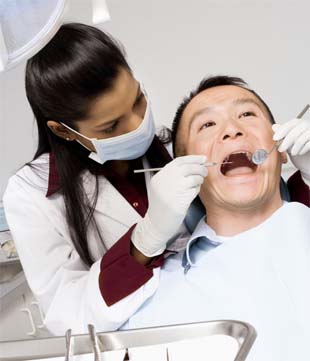
What is Botox®?
BOTOX® is a therapeutic agent derived from the bacterium, Clostridium Botulinum; Also known as Botulinum Toxin Type A. The brand, BOTOX®, is produced in controlled laboratory conditions and given in extremely small therapeutic doses originally for the treatment of blepharospasm (eye spasm) and strabismus (misalignment of the eye). BOTOX® Purified Neurotoxin Complex is a vacuum-dried form of purified botulinum toxin type A. and is being investigated for several conditions associated with overactive muscle activity.
BOTOX® comes in a vial containing 100u (units) of freeze-dried product. The vials are stored in the office at -5º F until the BOTOX® is reconstituted with normal saline. The results are reportedly best if used within 4 hours of reconstitution.
What Is BOTOX® Used For?
Other than for its originally intended purpose, treatment of blepharospasm (eye spasm) and strabismus (misalignment of the eye) this product has cosmetic applications as well. BOTOX® is FDA approved for cosmetic use to improve the look of fine lines and superficial wrinkles between the brows caused from every day brow furrowing as well as for migraines. Facial expressions like smiling, frowning or squinting can also cause wrinkles and BOTOX® is very effective in these areas. If you find that the early signs of aging are becoming apparent or if your facial expressions are causing premature wrinkles to appear, then BOTOX® may be for you. BOTOX® is also used in the prevention of wrinkles as well, by prohibiting you from making the facial gestures that cause wrinkles.
How Does BOTOX® Work?
Normally, your brain sends electrical messages to your muscles so that they can contract and move. The electrical message is transmitted to the muscle by a substance called acetylcholine. BOTOX® works to block the release of acetylcholine and, as a result, the muscle does not receive the message to contract. This means that the muscle spasms or movements that cause wrinkling, stop or are greatly reduced after using BOTOX®. Patients sometimes refer to the effects of the injection to their area of treatment as being “paralyzed” temporarily.
Patients with hyperhydrosis (intense sweating) also can temporarily remedy their disorder with BOTOX® injections. The BOTOX® is injected into the areas which sweat profusely like the under arms and backs of knees or palms of the hands, the BOTOX® blocks the release of acetylcholine near the sweat glands which cause the excessive sweating.
What Areas Can BOTOX® Be Injected?
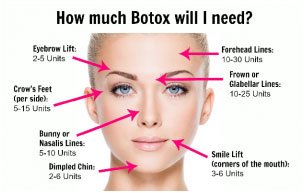
- Forehead Lines: Frontalis Muscle. Injections of 5 to 25u will usually be adequate. Horizontal lines (or “pleats”) are injected every 1 1/2 to 2 cm but high enough from the brow to prohibit brow ptosis.
- Glabella/Frown Lines: Corrugator Supercilii and Procerus muscles. Injections of 20 to 25u will usually be adequate. Approximately 5 injections can be given in this area, between 2 an 2.5u per corrugator and 2.5u into the procerus. The injector should take care not to inject pass the middle of the brow, or above or past the pupil. This could lead to brow ptosis.
- Crow’s Feet (Lateral Orbital Lines): Orbicularis Oculi and Procerus Muscles. Injections of 5 to 15u will usually be adequate. The pleats are injected with 2.5u. The injector should take care to avoid lid ptosis by injecting too close to the eyelids themselves.
- Bunny Lines (Transverse nasal): Injections of 5 to 25u will usually be adequate.
- Peri-oral Lines (Smoker’s Lines): Orbicularis Oris Muscle. 5u per line will usually be adequate.
- Marionette Lines: Depresssor Anguli Oris and/or Trangularis Muscles
- Mentalis Dysfunction (Chin “Dents”): Mentalis Muscle (especially after a failed chin augmentation surgery; augmentation mentoplasty). For a standard treatment, 20u of Botox can be injected into various points in the Mentalis to relax the mentalis muscle and prevent visible contour irregularities.
- Vertical Platysma Bands: Platysma Muscle. Check with your physician on the prescribed dosage of BOTOX® for your individual needs.
- Brow Lift: BOTOX® can be injected above the outer area of the brow to create a lifting effect. Make sure your injector is skilled in this area or the risk of brow ptosis may increase.
- Hyperhydrosis or Hyperhidrosis (excessive sweating): Not Shown. BOTOX® can be used to control hyperhydrosis by blocking the release of acetycholine. Acetycholine is the body’s chemical which stimulates the sweat glands.
- Armpits: Axillary
- Palms: Palmaris
- Soles of the Feet: Plantaris
Arrows depict possible injection sites that truly depend upon your own anatomy. Not everyone will need as many injections as the next, so please understand that you may not need the amount depicted in the diagram. You simply frown and then the dentist will inject where they feel the paralysis will be beneficial.
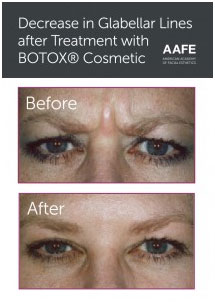
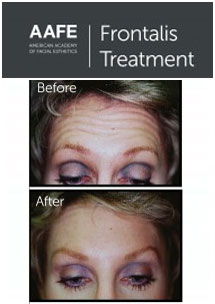
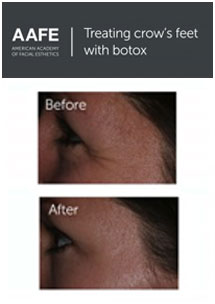
What To Expect At Your BOTOX® Appointment
BOTOX® is injected with a micro-needle into the muscle(s) or areas that your individual needs require. The most requested areas of treatment and complaint are the forehead and outer eye area. One to three injections are usually given per muscle. The company advises that patients report very little pain or discomfort associated with BOTOX®injections due the size of the micro-needle. It can sometimes feel like pressure and a stinging or burning, or sometimes you don’t feel it at all. I have felt a burning sensation a few times, and others I have felt nothing at all. (Ladies, if you are close to your menstrual period or on it, you may feel more pain due to heightened senses. Perhaps schedule a week or two after your menstrual cycle is over if you feel the treatment is uncomfortable).
After your treatment, you will usually see the effects of BOTOX® within a few hours to three days and up to two weeks to kick in.
In The Weeks Ahead
Maximum benefit is reached in one to two weeks. Commonly you will get re-injected every 3 months, however it’s your preference. The effects diminish gradually and you will begin to notice movement of the forehead.
How Long Does It Last?
The effects last approximately three months thereafter from a single treatment of BOTOX®, resulting in the smoothing of your skin and the improvement of fine lines and superficial wrinkles in the area of your treatment. When the effects start wearing off, you will notice a very gradual fading of its effects. At this point you will return for your next treatment. BOTOX® has proven itself again and again in eliminating superficial lines and wrinkles. Patients report that during a course of treatment their lines seem to disappear and the skin regains its former smoothness. I tend to agree, I had slight horizontal forehead wrinkles and a vertical frown line forming but it’s gone now.
Risks, Complications & Contraindications
Given its unique mechanism of action, BOTOX® offers sustained relief, dose after dose. As far as long term effects are concerned, treatment with BOTOX® can typically be repeated indefinitely. However, if you are pregnant or taking certain medications, you are not eligible to receive BOTOX® treatments. Pregnant women should not get Botox.
The effects of BOTOX® may be increased with the use of certain antibiotics (such as aminoglycoside antibiotics) or other drugs that interfere with neuromuscular transmission. Be sure to disclose any and all pre-existing medical conditions and all medications you may be currently taking before undergoing any treatment.
BOTOX® may cause temporary headaches, hematoma [: a mass of usu. clotted blood that forms in a tissue, organ, or body space as a result of a broken blood vessel], ectropion [: an abnormal turning out of a part (as an eyelid)], diplopia [: a disorder of vision in which two images of a single object are seen because of unequal action of the eye muscles — called also double vision], bruising, and temporary eyelid ptosis.
Afraid of getting botulism? They used to say not to worry, that you could inject that whole bottle and not get it. While this is true thus far with Allergan’s BOTOX®. Serious cases of botulism have been connected to non-approved forms of the paralytic. Please be sure you are receiving an FDA-regulated brand.
Does paralysis or droopiness of the eyelids cause you concern? This can happen and I have been told for eye ptosis, Iopidine 0.5% (apraclonidine hydrochloride) drops may help. Ask your physician about the protocol in the event of misjudgment or accidental BOTOX® leaching into the other muscles, before he or she injects you. I have also been told that localized injections of antibiotics may help, or oral neostigmine bromide (Prostigmin) can shorten the effects of BOTOX® by blocking acetylcholinesterase. Not all surgeons offer this and it is unknown to me how effective treatment is.
“Neostigmine inhibits the destruction of acetylcholine by cholinesterase, thus permitting freer transmission of nerve impulses across the neuromuscular junction. It also has a direct effect on voluntary muscle fibres and possibly on autonomic ganglion cells and neurons of the CNS.”
— http://www.rxmed.com
Please tell your Doctor if you have cardiac arrhythmia, bronchospam, a weak anal sphincter and other possible muscle weaknesses if you are to be treated with neostigmine.
Another option is oral acetylcholine chloride drops available at your local health food store or pharmacy. Please discuss any of these options with your surgeon before considering their usage
Also if you are on strong antibiotics such as Levaquin, Cipro or Clindamycin, you may not get the same wear out of your BOTOX® injections as compared to if you were not taking them. It is sometimes best to wait until you are finished with your prescribed course of antibiotics. Just like you should tell your doc if you are on aminoglycoside antibiotics because they can enhance the effects of Botox.
The Least You Need To Know
- What: Clostridium Botulinum; Also known as Botulinum Toxin Type A
- Why: Other than for its original purpose, treatment of blepharospasm (eye spasm) and strabismus (misalignment of the eye) this product has cosmetic applications as well. BOTOX® injections improve the look of fine lines and superficial wrinkles caused from every day facial exercises like smiling, frowning or squinting.
- When: from whenever you want it from now to usually the late 40’s–sometimes 70’s.
- Who: Dr. Burton, Dr. Portis, and Dr. Waggener
- Where: Maryland Farms Family Dentistry, 5111 Maryland Way, Suite 306 Brentwood, TN 37027. We use an FDA-approved brand of Botulinum Toxin if you are in the U.S.
- Risks: READ THEM!
- Incisions/scars: n/a
- Anesthesia: n/t
- Duration: 30 min.
- Pain Factor: just the pin pricks of the injection and a few headaches are possible for the first week. However, slight stinging or burning, or at the very least, pressure during injections may occur.
- Swelling: very mild
- Bruising: rare, but possible
- Post-operative instructions: After treatment, you will usually see the effects of BOTOX® within a few hours to three days.
- 1st Post-op visit: n/a
- 2nd Post-op visit: n/a
- Return to work: immediate
- Activity: be careful for the first few days as care must be taken in restricting the amount of muscle movements in the treatment area while it settles in.
- Sun exposure: Wear sunblock as sun exposure can prolong bruising or cause the development of hyperpigmentations in the treatment area.
- End result: Maximum benefit is reached in one to two weeks according to the company but I found my third day was just the same as my 2nd week.
- Loss of Sensitivity: numbness is possible but very rare.
- Anything else? The effects of BOTOX® may be increased with the use of certain antibiotics or other drugs that interfere with neuromuscular transmission. Be sure to disclose any and all pre-existing medical conditions and all medications you may be currently taking before undergoing any treatment.
- Longevity: The effects last approximately three months thereafter from a single treatment of BOTOX®. Resulting in the smoothing of your skin and the improvement of fine lines and superficial wrinkles in the area of your treatment.
- But Wait! There’s More! When the effects start wearing off, you will notice a very gradual fading of its effects. At this point you will return for your next treatment.

